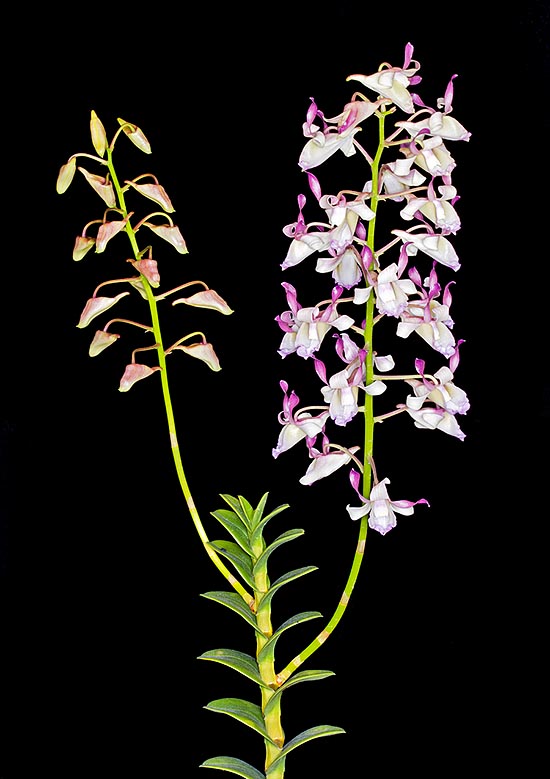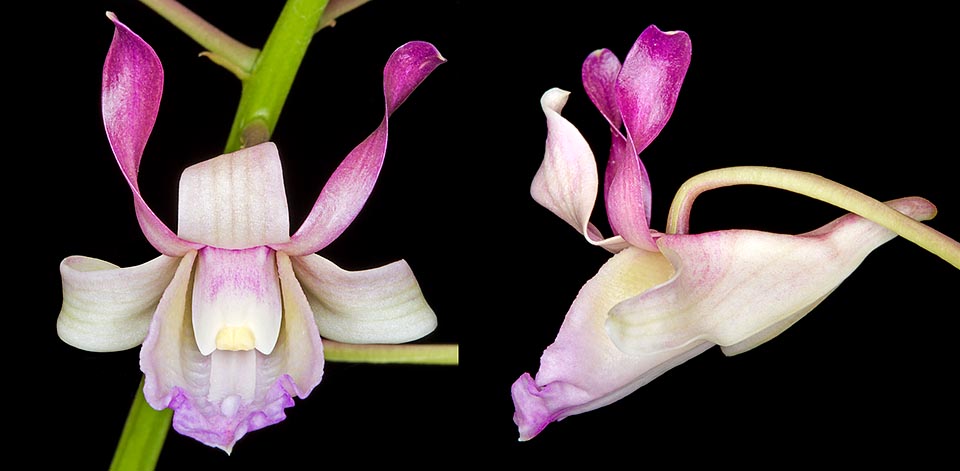Family : Orchidaceae

Text © Pietro Puccio

English translation by Mario Beltramini

The Dendrobium taurinum grows epiphytic at low altitudes, often in mangrove forests, in the Philippines and the Moluccas. Very appreciated in cultivation, has originated various hybrids © Giuseppe Mazza
The name of the genus is the combination of the Greek substantives “δένδρον” (dendron) = tree and “βίος” (bios) = life, with reference to the numerous species of the genus living on the trees; the name of the species is the Latin adjective “taurinus, a, um” = of bull, with reference to the flowers resembling the head of a bull.
Common names: bull orchid, bullface orchid (English).
The Dendrobium taurinum Lindl. (1843) is an epiphytic species with slightly compressed cylindrical pesudobulbs, up to more than 1,5 m long and of 1,5-2,5 cm of diameter, provided in the upper half of oblong-elliptic leaves, 6-15 cm long and 4-5 cm broad, coriaceous, of dark glossy green colour.
Racemose inflorescences from the upper nodes, erect, 10-50 cm long, bearing numerous flowers of about 6 cm of diameter with cream white or greenish white sepals, lavender to dark purple petals and white labellum suffused of purple at the margins. Almost triangular dorsal sepal with curved pointed apex, about 3 cm long and 1 cm broad, triangular lateral sepals with curved pointed apex, 4 cm long and 1,5 cm broad, merged at the base of the column to form a sort of conical, up to 2 cm long, spur (mentum).
Linear petals, erect, twisted, about 4 cm long, trlobed labellum, 3,5 cm long and 2,5 cm broad, run at the base by three lamellae, with median lobe having ruffled margin.
It reproduces by seed, in vitro, micropropagation and division, to be done by the vegetative restart, with each section provided of at least 3-4 pseudobulbs.
Species appreciated by the collectors due to the delicate shades of colour of its flowers of long duration, 4-6 weeks, and amply utilized in the hybridizations, requires high luminosity, medium-high temperatures in summer, 24-32 °C, with humidity of the 70-85%, averagely cooler temperatures in winter, with lowest night ones not under the 16 °C; in all seasons is fundamental a constant movement of the air. During the growth period of the pseudobulbs the waterings must be regular and abundant, more spaced in winter till the vegetative restart, utilizing for the watering and nebulisations rainwater, from reverse osmosis or demineralised. The fertilizations, during the vegetative period, duly distributed and alternated in way to avoid salts accumulation, are to be done preferably with hydrosoluble balanced products, with microelements, at ½ - ¼ of the dosage suggested on the package.

Pseudobulbs can exceed the metre and a half and the inflorescences the 50 cm. The flower here seen by front and by side, has about 6 cm of diameter © Giuseppe Mazza
The species is reported in the appendix II of the CITES (species whose trade is internationally ruled).
Synonyms: Callista taurina (Lindl.) Kuntze (1891); Durabaculum taurinum (Lindl.) M.A.Clem. & D.L.Jones (2002).
→ For general notions about ORCHIDACEAE please click here.
